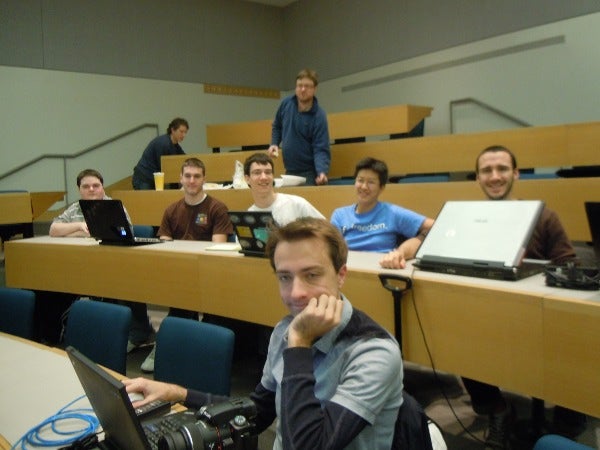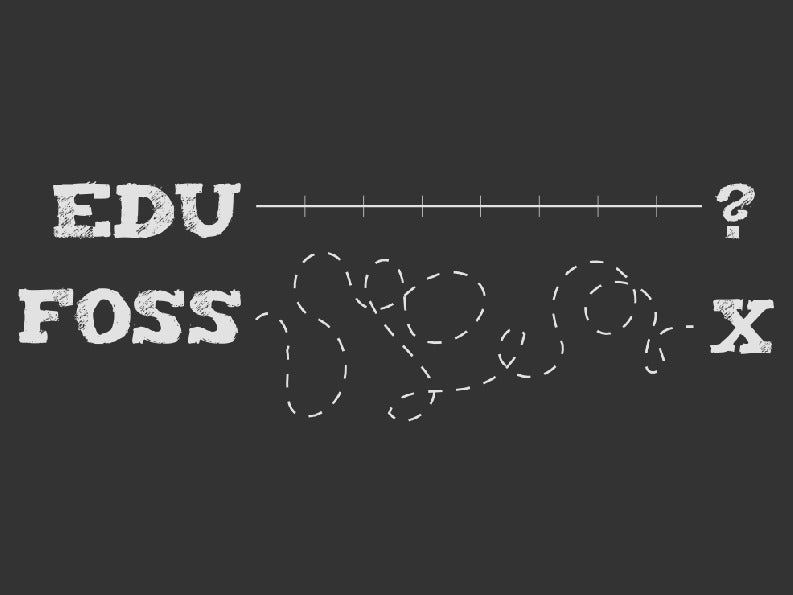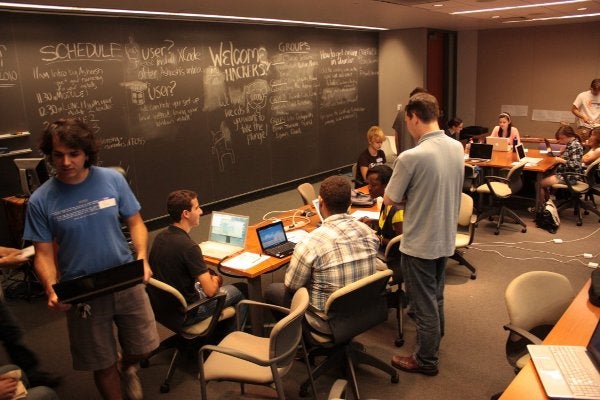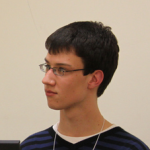5 minutes. A ballroom full of administrators, faculty, and students looking for ways to transform student engagement in engineering education. They may have heard of open source before (vaguely), but you've got 20 slides to convince them that it's actionable. What would you tell them?
This presentation (slide deck and notes released under a Creative Commons Attribution Share-Alike 2.5 license) is the answer Mel Chua and I gave last weekend at the Engineer of the Future conference. We'll put in a few key points from our own slides below, and then ask you to share your own rocket pitches afterwards.
Sebastian: This is Mel. She studied engineering in college and got involved in the academic world first, then started working in open source communities. She'll be speaking from the academic side of the house tonight.
Mel: This is Sebastian. He's spent the last three years doing release engineering in the open source world. Now he's starting his academic career as an undergraduate. He'll be speaking from the open source side of the house tonight.
Sebastian: Our thesis tonight is that engineering education and open source are both communities of practice that have much to learn from each other.
Mel: In academia, we want to get students involved in distributed, large-scale, real-world projects for actual users. We want them to work on stuff that makes a difference, and we want them to work with people who are good at what they do, and who love what they do - projects folks who are passionate. Where do we find these projects?
Sebastian: In the open source world, we are these projects. We work with thousands of people from around the world to impact millions on projects that are software, but also movies, or books, or hearing aids.
A hackathon at the University of Pennsylvania. Photo by Asheesh Laroia, CC-BY-3.0-Generic.
Mel: One thing that academia is good at is building scaffolding; it's really quite remarkable to take hundreds of students with different backgrounds who are new to a field, and a few years later, they're practicing in that field. We take lots of new people at once and get them started in a discipline. We call this teaching.
Sebastian: On the other hand, open source communities aren't so good at getting new people started. We're hungry for new contributors - and you may be one of them - but the getting-started experience might be confusing. You might feel lost. Sometimes we don't know how to handle new people well when they arrive. We don't know how to teach them.
Mel: In academia, we have credibility. We get pieces of paper that make people think we know things, make them listen to us. The tradeoff is that with credibility comes hierarchy and needing to ask for permission and approval to get credit.
Sebastian: On the other hand, in the open source world, we don't have to ask for permission; we just jump right in. Our tools track who does what, but the tradeoff is that we need to convince people over and over again that our projects are actually good.
Mel: You might notice that the needs from one world tend to mesh with the strengths of the other. So what happens when you bring these two worlds together? That's what the members of the Teaching Open Source community are trying to find out. We're a group of open source contribuors and university faculty experimenting with exactly that.
Sebastian: We have an example. Professor Matt Jadud of Allegheny College brought his human interface design class into Fedora, a project for making a free software operating system. They worked within the community to look at our website design.
Mel: So that's bringing open source into the classroom. Last weekend Sebastian and I brought students into open source. A group of software engineering seniors from Professor Heidi Ellis's class at Western New England College came to their first GNOME hackathon at MIT, and we served as tour guides for the day.

The Western New England College team and friends at the GNOME Summit. Photo by Heidi Ellis, CC-BY-SA-2.0.
Sebastian: When Matt's students came in, the community reaction was something like this: "Wow, you really want to work on our webpage? Here are the tools, let's talk about this!" We'd wanted an evaluation of our website for a long time, but nobody had been able to bring in the folks to do the work before.
Mel: And Heidi's students went home from the hackathon excited--they had just spent a day being treated as equals by talented hackers from all over. People were asking questions about their project, mentoring them, pitching in to help. It was a "whoa, the world has possibilities!" moment.
Sebastian: This sounds like a perfect match--and sometimes it is, with the tools and skills of one world perfectly fitting the needs of the other. But the trick is figuring out how to translate between the two cultures, which are very different.

Mel: In academia, you know how you're going to get where you're going. You take class A, class B, class C, and then 4 years later you get a degree. But you don't know where you're going sometimes. If you ask seniors what they're going to do when they graduate, a lot of times they still don't know.
Sebastian: In open source, you know what you're going to do; you're making a book, an operating system, whatever you're working on. But you might not know how you're going to get there or how long it's going to take. You'll figure that out along the way.
Mel: They have very different rhythms and cycles, but if we can find ways to join the two worlds, we're unlocking something very powerful: schools can teach these communities of practice how to build scaffolding and how to design apprenticeships so it's easier for new people to get involved.
Sebastian: And open source communities can share the technologies and the practices they've developed for collaborating; these are the things that let us be our own bosses, find our own mentors, and really run with our own projects.
We closed our slide session with a plug for our Birds of a Feather (BoF) gathering at lunch the next day. Basically, we used the presentation to start the conversation. Generate the interest that would get people to join us for lunch, where we could fill in more detail and answer--and ask--more specific questions. It seemed to work--the audience stuck around and the BoF was full.
But let's take it even further. We're curious how this message resonates with you, and how you might re-tell the story.
So our question to you, dear readers, is what would your 5-minute pitch for open source in undergraduate technical education be? Slide decks, rocket pitch, bullet points, videos--anything you can throw at us, we'll take a look at. Comments! Go!








Comments are closed.